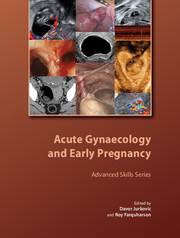Book contents
- Frontmatter
- Contents
- About the authors
- Acknowledgements
- Abbreviations
- Preface
- 1 Organisation and delivery of emergency care in early pregnancy and acute gynaecology
- 2 Epidemiology and aetiology of miscarriage and ectopic pregnancy
- 3 Diagnosis of miscarriage
- 4 Conservative and surgical management of miscarriage
- 5 Management of hyperemesis gravidarum
- 6 Diagnosis and treatment of recurrent miscarriage
- 7 Differential diagnosis and management of molar pregnancy
- 8 Drugs in early pregnancy
- 9 Diagnosis of tubal ectopic pregnancy
- 10 Conservative management of tubal ectopic pregnancy
- 11 Surgical management of tubal ectopic pregnancy
- 12 Diagnosis and management of non-tubal ectopic pregnancy
- 13 Diagnosis and management of acute pelvic pain
- 14 Management of vaginal bleeding in the acute clinical setting
- 15 Current concepts in screening and outpatient management of pelvic inflammatory disease
- 16 Diagnosis and management of haemorrhagic and septic shock
- 17 Role of minimally invasive surgery in acute gynaecology
- Index
17 - Role of minimally invasive surgery in acute gynaecology
Published online by Cambridge University Press: 05 July 2014
- Frontmatter
- Contents
- About the authors
- Acknowledgements
- Abbreviations
- Preface
- 1 Organisation and delivery of emergency care in early pregnancy and acute gynaecology
- 2 Epidemiology and aetiology of miscarriage and ectopic pregnancy
- 3 Diagnosis of miscarriage
- 4 Conservative and surgical management of miscarriage
- 5 Management of hyperemesis gravidarum
- 6 Diagnosis and treatment of recurrent miscarriage
- 7 Differential diagnosis and management of molar pregnancy
- 8 Drugs in early pregnancy
- 9 Diagnosis of tubal ectopic pregnancy
- 10 Conservative management of tubal ectopic pregnancy
- 11 Surgical management of tubal ectopic pregnancy
- 12 Diagnosis and management of non-tubal ectopic pregnancy
- 13 Diagnosis and management of acute pelvic pain
- 14 Management of vaginal bleeding in the acute clinical setting
- 15 Current concepts in screening and outpatient management of pelvic inflammatory disease
- 16 Diagnosis and management of haemorrhagic and septic shock
- 17 Role of minimally invasive surgery in acute gynaecology
- Index
Summary
Introduction
Minimally invasive surgery is increasingly being used to diagnose and treat women presenting with acute gynaecological disorders. Laparotomy was previously the standard treatment for acute gynaecological emergencies such as ruptured ectopic pregnancy or ovarian cyst accidents. In most women the diagnosis was first confirmed by laparoscopy before open surgery was carried out. As the technology and surgical experience have improved, more women have been managed exclusively using laparoscopic surgery. New instruments have been developed that allow safe manipulation of the pelvic organs. Procedures such as irrigation, haemostasis and intra-abdominal suturing can be carried out without the need for open surgery. Minimally invasive surgery can now be used for both the diagnosis and treatment of many acute gynaecological conditions. Laparoscopic surgery can therefore be limited to a diagnostic procedure if the diagnosis is in doubt or expanded into an operative procedure once the diagnosis has been made and immediate treatment is required.
Benefits and risks of minimally invasive surgery
Laparoscopic surgery is associated with reduced postoperative pain, intraoperative blood loss, wound complications, adhesions, length of hospital stay and recovery time compared with laparotomy. Additional benefits include better visualisation and more precision while operating. Laparoscopic management of ectopic pregnancies has been proved to be advantageous in terms of treatment outcomes, postoperative adhesions, hospital stay, cost and effects on long-term fertility. Laparoscopic surgery can also be used to treat ectopic pregnancy in obese women.
- Type
- Chapter
- Information
- Acute Gynaecology and Early Pregnancy , pp. 223 - 232Publisher: Cambridge University PressPrint publication year: 2011



